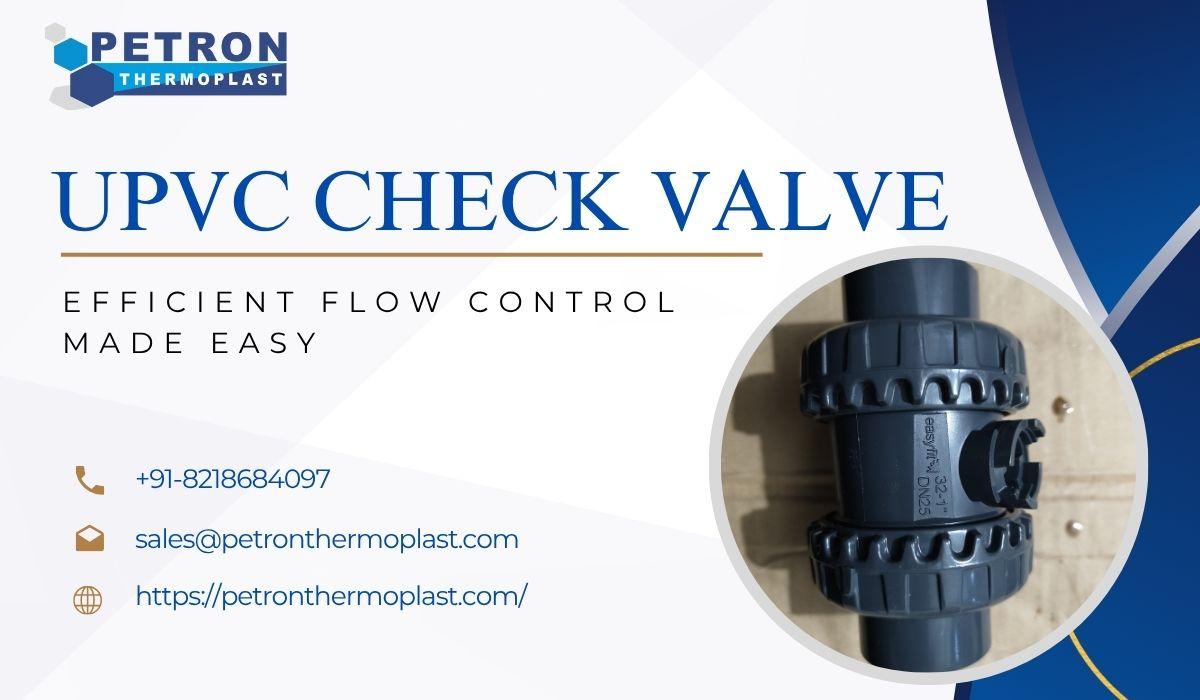In modern industrial systems, maintaining safe and efficient fluid flow is critical. One essential component that helps ensure this is the UPVC check valve. Known for its reliability, chemical resistance, and cost-effectiveness, the UPVC (Unplasticized Polyvinyl Chloride) check valve has become a go-to solution in numerous applications ranging from chemical processing to water treatment.
In this blog, we’ll explore the functionality, advantages, and industrial applications of UPVC check valves—and why they are an ideal choice for efficient flow control.
What is a UPVC Check Valve?
A UPVC check valve is a type of non-return valve designed to allow fluids to flow in only one direction while preventing backflow. It operates automatically, meaning it opens when fluid flows in the forward direction and closes when the flow reverses. This mechanism ensures system integrity, reduces wear on pumps, and prevents contamination.
UPVC check valves are made from unplasticized PVC, which is rigid and more durable than regular plasticized PVC. This makes them ideal for use in aggressive chemical environments and pressurized systems.
How Does a UPVC Check Valve Work?
UPVC check valves are typically designed with a spring-loaded disc or a swinging flap. When fluid enters the valve in the correct direction, it pushes the disc open, allowing flow. When flow stops or reverses, the disc automatically closes due to gravity or spring tension, thus preventing backflow.
The simplicity of the design allows for maintenance-free operation and long service life, even in demanding conditions.
Key Features of UPVC Check Valves
- One-Way Flow Control:
Prevents reverse flow, ensuring safety and efficiency in pressurized systems. - Excellent Chemical Resistance:
UPVC is resistant to a wide range of chemicals including acids, alkalis, and salts, making these valves ideal for chemical processing industries. - Corrosion-Free Construction:
Unlike metal valves, UPVC valves do not corrode, ensuring long-term durability in moist or corrosive environments. - Lightweight Design:
Easy to handle and install, especially in systems where weight is a concern. - Low Maintenance:
With no external power source or manual intervention required, these valves operate reliably for years with minimal upkeep. - Affordable:
Compared to metal or specialized plastic valves, UPVC valves offer a cost-effective solution without compromising performance. - Versatile Connection Options:
Available in socket, threaded, or flanged ends to fit into various piping systems.
Types of UPVC Check Valves
Depending on system requirements, several types of UPVC check valves are available:
1. Swing Check Valve:
Uses a hinged disc that swings open when fluid flows forward and closes when flow reverses. Ideal for systems with steady flow.
2. Spring-Loaded Check Valve:
Incorporates a spring mechanism that allows for quick and automatic shut-off. Ideal for vertical installations or pulsating flow conditions.
3. Ball Check Valve:
Features a ball that seals against a seat when backflow occurs. Simple and effective for low-pressure systems.
Applications of UPVC Check Valves
Thanks to their excellent material properties and functional reliability, UPVC check valves are used in a variety of sectors:
🌊 Water & Wastewater Treatment
Ensures directional flow in filtration, chlorination, and distribution systems.
🧪 Chemical Processing
Handles corrosive fluids without degradation, ideal for acid and alkali transport.
🌱 Agriculture & Irrigation
Maintains system pressure and prevents backflow contamination in irrigation lines.
🍶 Food & Beverage Industry
Used in clean water and non-reactive process lines where hygiene and chemical resistance are key.
🏭 Pharmaceuticals
Ensures controlled, clean flow in pharmaceutical-grade fluid systems.
🐠 Aquaculture Systems
Maintains steady water flow in fish tanks and breeding systems without pump stress or back pressure.
Why Choose UPVC Check Valves Over Metal Valves?
While metal valves are traditionally used for heavy-duty applications, UPVC check valves offer several advantages in terms of cost, corrosion resistance, and ease of installation:
| Feature | UPVC Check Valve | Metal Check Valve |
| Corrosion Resistance | Excellent | Moderate to Poor (requires coating) |
| Weight | Lightweight | Heavy |
| Maintenance | Low | High |
| Chemical Compatibility | Wide range | Limited without liners |
| Cost | Affordable | Expensive |
| Installation | Easy | Labor-intensive |
Technical Specifications (Typical Range)
| Parameter | Value |
| Size Range | ½” to 4” (custom sizes available) |
| Material | Unplasticized Polyvinyl Chloride (UPVC) |
| End Connections | Socket / Threaded / Flanged |
| Pressure Rating | Up to 10 bar (depending on size & design) |
| Temperature Range | 0°C to 60°C |
| Standards | ASTM D1784, ISO 727, DIN compliant |
| Applications | Water, chemicals, wastewater, food & pharma |
Conclusion
The UPVC check valve is an indispensable component in modern fluid systems where efficient, low-maintenance flow control is needed. With its chemical resistance, affordability, and versatility, it offers a long-lasting solution across a wide range of industries.
At Petron Thermoplast, we supply a complete range of high-quality UPVC check valves in various sizes and configurations to meet your exact industrial needs. Whether you require solutions for water treatment, chemical processing, or irrigation, our UPVC valves deliver dependable performance you can trust.



